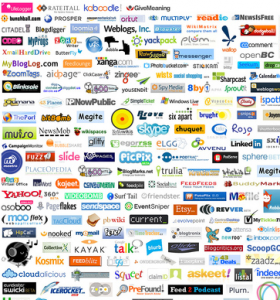I had the opportunity earlier this week to give my colleagues an overview of the various social networking sites out there and how one of our clients might make use of them. Most of the conversation was focused on explaining, conceptually, how social networking sites like Facebook and Twitter are being used — and the differences between how a teenager uses them compared to, say, how a thirty-nine year old author does.
All of this coincided with a comment from an offline friend/acquaintance who recently visited my website for the first time and expressed a friendly (albeit curmudgeonly) skepticism of all things online: “I worry (but not much) that we’re creating a generation of alienated loners and social misfits that substitute ‘linking’ for relationships.”
Well… thanks for stopping by.
Explaining things to other people often helps me understand them on a deeper level of my own. Apart from the strategic objectives we have for our client, I came away from the meeting with a clearer understanding of how and why I participate in these various networks. It also forced me to reevaluate my own internal rules and guidelines for that participation. I wasn’t particularly surprised to discover that I’d strayed a bit from my initial intentions, but it did give me cause to step back and think through whether or not I wanted to be where I was at now.
 Twitter
Twitter
Originally, this micro-blogging/streaming chat site started as a way for people to stay connected through mobile devices, by answering the question “What are you doing?” Since then, it’s evolved into an interesting little community of interconnected, micro-networks.
On Twitter, you “follow” people and people follow you. It isn’t, however, reciprocal; I can follow you but you aren’t required to follow me. And if you don’t want someone to follow you, you can “block” them (effectively rendering yourself invisible to them). You can also set your status to “private” which means you have to approve anyone before they can follow you or view your posts.
Users post single line “tweets” to the site, no more than 140 characters long. These tweets are streamed in a timeline, showing all of your activity and interaction on the site as a streaming conversation. So if I’m following you, I can see yours. And you can respond to someone else’s tweet by entering their user name preceded by the @ symbol, which adds your tweet into their timeline. You can also send a private message to someone as well, called a DM (or “direct message”).
Make sense?
I was introduced to Twitter by my friends at Fusionary a few years ago, and it seemed like a good place to lay a foundation to promote my writing and podcasting. But it wasn’t long before I was participating on a different level. The evolution from my self-serving intentions to being an active member of a community was due in no small part to the kind of connections I made on my first visit to Twitter.
I can remember picking out a few tweets from the public timeline, checking out a page or so of what those users had posted, looking at their related websites, and hitting the follow button. The first one I followed was probably Akelaa or DarkGracie. And I’m fairly certain that the first person to follow me was Mercy. It was the luck of the draw on those timeline picks, but it paid off. These are all people I follow even now, a few years after the fact, and I consider them to be friends.
 One of the rules I’ve made for myself is that I can’t more than 100 people at a time on Twitter. This is more for logistical reasons than anything else. I just can’t keep track of that many other people — or, I can get way too distracted by chatting with all of them to get any real work done.
One of the rules I’ve made for myself is that I can’t more than 100 people at a time on Twitter. This is more for logistical reasons than anything else. I just can’t keep track of that many other people — or, I can get way too distracted by chatting with all of them to get any real work done.
I’ve followed upwards of 200 people in the past, but I found that I continued to interact with the same core group no matter how many I was following. So I went through and distilled my list down. I find that the numbers can creep back up on me from time to time, so I try to clean it up again every few months.
It’s difficult to explain what that core group is to me. Many of them are readers/listeners who have taken the time to seek me out and chat with me about Assam & Darjeeling and Matters of Mortology — which pretty much makes my day every single time it happens.
Others are people who I think are funny or interesting… other writers that I enjoy eavesdropping on and interacting with… a few professional colleagues… some newswire alert organizations… and so on. I should mention that there are a few I follow who don’t follow me, and I’m fine with that. The list of people following me is somewhat high, edging closer towards 500. It isn’t uncommon for people on the big list to catch my attention and get added to my core list.
But the real core are those handful of people that say Good Morning every day, who share encouragement and support, who aren’t afraid to laugh or cry or rage at the sky in front of the rest of us. As such: A few nights ago I was up late and posted that I was feeling a little low, a little blue. It didn’t take long for a whole bunch of people to jump in to lend a hand — Dayngr, Mousewords, and Yvonner to name but a few. That was my core, taking care of me. Just like we all do for each other, now and again.
All in all, my interaction with Twitter is a mix of connections between a couple of overlapping mini-networks: My readers/listeners, the people I follow, and the people who are my friends. While it’s difficult to explain how that works to people “outside” of Twitter, it’s all genuine and I’m grateful for the people there… so much so, that I dedicated The Winter Chap to them.
 Plurk
Plurk
I found Plurk during one of many of Twitter’s “Fail Whale” moments. Plurk is a suitable alternative; consider it a variation on a theme. It’s a different kind of tool, a different kind of network than Twitter and there are some similarities, but it’s also got a number of features that are really quite nifty (inline image/video display and threaded conversations, for instance). The interactions there have a distinct quality to them, different than what’s on Twitter.
Although a lot of people have become factionalized, picking one over the other, I’m not too bothered by having a presence on both sites. I’ve got a few crossover friends who show up in both places — like Alousionist and Devyl — but Plurk is actually quite nice because it’s a point of contact with a number of my overseas friends/listeners/readers who don’t use Twitter — like Tenebrous Pau and Dakota Blackwater in England and Tere in Indonesia.
Over time, I’ve found that Plurk is a lot more work to keep up with. The conversations are longer and can go on for days. Oddly enough, my list of friends there is much shorter. But those few connections are what keeps me connected to that system.
 Facebook
Facebook
Facebook is a lot of things, to be sure. The use of “friend” to define connections in your network is a clever one. However, a lot of people on Facebook seem to be in a competition to collect as many “friends” as they can, as though the value of their online persona is measured by quantity.
That goes somewhat against my nature. I don’t have many friends, but the few I do have are very close to me. Thirteen years ago, moving from the West Coast to the Midwest, I lost a few of those connections that were important to me. And there are people I’ve known for years, going all the way back to middle school who are scattered all around the country. Facebook is one of many ways to renew and maintain some of those relationships.
As such, it’s the place where I’m perhaps most selective about who I accept invitation requests from. But it’s also a place where I’ve ended up adding a few of the people I’ve come to know on some of the other sites because, somewhat to my surprise, they’re people that I can call “friends” as well.
I never would have ended up on Facebook — or, at least, not so soon — if I didn’t have a teenage son. As a parent, you have to keep pace with where your kids are at and pay attention to what they’re doing, who they’re interacting with, and even engage with them in “their” world. I’m extremely fortunate that I have a very cool son with some very cool friends, who don’t get into too much trouble and don’t mind “friending” the old guy.
 MySpace, Bebo, Pownce, Identi.ca, BrightKite, et al
MySpace, Bebo, Pownce, Identi.ca, BrightKite, et al
There are lots of other systems and networking sites out there. I have a profile page on a fair number of them and I use Ping.fm to post updates to them all at the same time, but I don’t really consider them a part of my online community. First off, there’s just too damn many of them. And a lot of them don’t do it as well as the few I’ve mentioned above.
The one exception is LinkedIn. This is a networking site geared towards business professionals and that’s chiefly what I use it for. I have a profile there and actively make and maintain connections with people — mostly folks I’ve I’ve worked with — but I don’t stream my Ping.fm to it, for reasons which are obvious if you follow me on any of the other networks.
“What are you doing?”
Well, that went on a bit longer than expected.
But to come full circle, my discussion earlier this week made me take a step back and look again at my presence on all of these sites and networks. In my media ethics and mass communication classes in college, there was sometimes an underlying, McLuhan-esque concern about the dehumanization that came about from the adoption of technology.
Looking back, it does seem odd that someone teaching media classes made it a point to not watch television (he even had a “Kill Your Television” bumper sticker). This was almost twenty years ago, before personal computers were so common and certainly before the advent of Internet in society, so perhaps things have changed.
It certainly left me with an uneasy distrust (and even scorn) for popular culture and technology. But I got over it. Obviously.
And yet… there’s an echo of it in the comments my site visitor made earlier, and I have to admit that I slip back into that border-line Luddite mentality when I go through periodic reassessments like the one I did earlier this week. But if you’ve stuck with this so far, it’s obvious that there’s a lot of things happening in these places that are interesting and valuable to me on a variety of levels. If anything, the chief result of my self-audit was a validation of all of the good things I mentioned above. However, it did cause me to reassess and revise my friend/follower/following lists on the various sites.
In all honesty, there was just too much to keep connected to. The bigger those lists got, the less I enjoyed the interaction. The more of an obligation or chore it became. And there’s really only two solutions to that problem.
Since I wasn’t going to unplug entirely, I had to take a closer look at my lists.
This is a touchy subject. Lots of people feel bad on one level or another if their friend/follow request isn’t reciprocated. And being removed from someone’s list is often viewed as a personal rejection. Some people feel it, deeply. I admit, I’ve felt it myself from time to time. Which is why I’ve take the time to formalize my interaction along all these different channels, operating at a level appropriate to my relationship with people I know (and with people I don’t).
 If you got filtered out on one of them, it’s possible that we’re still connected on another one. If that’s not the case, I can only say that it wasn’t personal. Most likely, we just didn’t share a whole lot of interaction, activity, or connection.
If you got filtered out on one of them, it’s possible that we’re still connected on another one. If that’s not the case, I can only say that it wasn’t personal. Most likely, we just didn’t share a whole lot of interaction, activity, or connection.
Who know? Maybe we’ll reconnect down the road.